355 Search Results for assessment
December 15, 2016
by Carole Zangari -
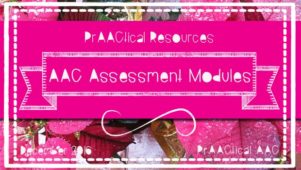
If you talk to a dozen SLPs about AAC assessment practices, chances are great that at least 10 of them aren’t quite comfortable with the area. That’s why we’re so very appreciative of the efforts of Dr. Janice Murray, Helen Bell, Helen Whittle, and Osman Javaid of Manchester Metropolitan University, Sara Dale from the ACE Centre, and Janet Scott of Scottish Centre of Technology for the Communication Impaired for this terrific set of learning activities. If you want to learn more about doing good AAC assessments, this resource is a fine one to check out. Level 1 Module Level 2 consists of several modules, each of which can be accessed here. Thanks to all involved in this collaboration for sharing it with the rest of us!
August 31, 2016
by Carole Zangari -
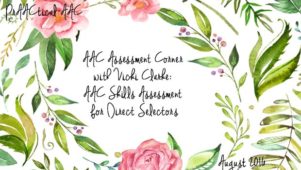
The month of August is almost over and we’ve saved the best for last. The month wouldn’t seem complete without hearing more of Vicki Clarke’s ideas on AAC assessment. In addition to many other things, Vicki’s practice, Dynamic Therapy Associates, does 50+ of these evaluations each year, both in the clinic and in school settings. In this post, Vicki shares some thoughts on assessing the AAC skills of people who use direct selection. As always, she packs in a lot of information and generously provides the protocol and data collection forms that she uses. You can explore some of her previous posts in the AAC Assessment Corner series here. * ::::::::::::::::::::::::::::::::::::::::::::::::::::::::::::::::::::::::::::::::::::::::::::::::::: AAC Skills Assessment for Direct Selectors I spent the morning with a great group of students at the University of Georgia (UGA) in Dr. Satterfield’s AAC class. I was asked to talk with them about AAC assessment with an emphasis on... [Read More...]
July 27, 2016
by Carole Zangari -
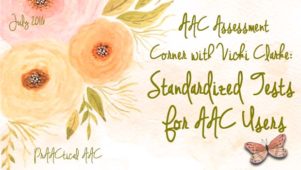
Do you have a love-hate relationships with formal testing? Are you required to use normed tests with your minimally verbal clients? Looking for recommendations on which tests to use? AAC specialist Vicki Clarke has you covered! Like many of you, I’ve had mixed feeling when it comes to using normed assessment instruments with my AAC learners, particularly when we needed to modify the test materials or administration procedures in order for them to be able to participate and respond. If the client can’t point to pictures, give a verbal response, or sit through an entire test, we have no choice but to adapt how the test is administered. As we all know, when we adapt test materials (e.g., putting the test items on an eye gaze board) or procedures (e.g., partner-assisted scanning), we lose the ability to use the normative data. We can, though, compare our learners to themselves at... [Read More...]
June 22, 2016
by Carole Zangari -
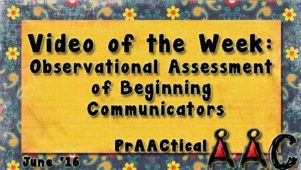
In last week’s video, we heard from SLP Maureen Nevers about the principles and practices used in assessing individuals who are at the beginning stages of communicative development. Today, we continue that theme and focus more specifically on using observation to collect assessment data on the form and function of communication. In this video, Maureen works through some video examples to demonstrate how brief observations of interaction can yield useful information about how and why the individual is communicating. You can visit their Communication Training Series webpage to see more from this wonderful team and get the specific resource documents for this presentation. Many thanks to the Angelman Syndrome Foundation for creating and sharing these videos. Direct Link to Video: https://www.youtube.com/watch?v=1qvvKNZEGMs&list=PLihsTkrStCHZVZBHDC0Qr7z10cYWC0ltx&index=36
June 15, 2016
by Carole Zangari -
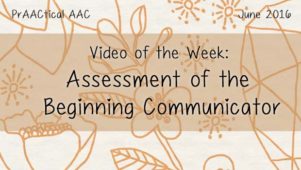
Looking to strengthen your assessment practices with beginning users of AAC? The Angelman Syndrome Foundation’s Communication Training Series has a two-part presentation on this topic that will be of interest to professionals and families alike. In this video, SLP Maureen Nevers discusses a range of prAACtical strategies and tools for gathering meaningful assessment data that helps guide intervention. One important note: Don’t skip this just because you are not currently working with individuals who have Angelman Syndrome. Like their other videos, the information in this presentation is relevant to those working with children, teens, and adults with a wide range of developmental disabilities. Direct Link to Video: https://www.youtube.com/watch?v=pgrsr8a2EKA&index=35&list=PLihsTkrStCHZVZBHDC0Qr7z10cYWC0ltx Kudos to the Angelman Syndrome Foundation for this outstanding series of training videos, and for making them freely available. Interested in this topic? Stay tuned for the second video on this topic in a future post.
June 1, 2016
by Carole Zangari -

Today, we welcome back Vicki Clarke with more helpful information on conducting AAC assessments. If you work with individual who are at the early stages of communicative development, this post is for you! :::::::::::::::::::::::::::::::::::::::::::::::::::::::::: Some of my most favorite students are those who, at first, may not seem to notice me at all. Sometimes these students seem to exist in their own worlds. They don’t seem to respond in ways we would expect: looking, attending, listening, or gesturing. They may have a diagnosis of Autism, significant developmental delay, epilepsy, or any number of syndromes. I love these kids, and unfortunately, these are often the students who don’t get referred to me. Sometimes it takes years of working in a district before I get to see students with significant developmental delays. These children are typically served in classrooms for students considered to be severe/profound or multi-handicapped. Honestly, I usually get the... [Read More...]
May 5, 2016
by Carole Zangari -
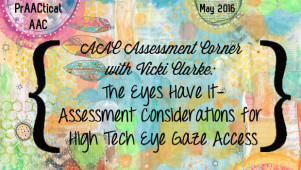
AAC assessment is an area that most professionals struggle with for one reason or another. I am so grateful to Vicki Clarke for returning to share her thoughts on the prAACticalities of conducting these evaluations. If you are looking for tips on assessing someone who needs high tech eye gaze AAC, this post is for you. For other posts authored by Vicki, click here. ::::::::::::::::::::::::::::::::::::::::::::::::::::::::::: The Eyes Have It: Assessment Considerations for High Tech Eye Gaze Access Eye gaze control for AAC device access is a hallmark technological achievement in the world of speech generating devices. For people with significant motor challenges we are no longer limited to scanning as our one choice for AAC access. AAC Specialists have been using light tech eye gaze boards and PVC pipe frames with these friends for years, but now we are able to offer voice output. Eye gaze is for a much... [Read More...]
March 17, 2016
by Carole Zangari -
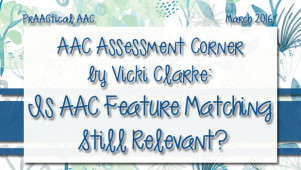
Today, we welcome back Vicki Clarke, a regular contributor to PrAACtical AAC, with another edition of AAC Assessment Corner. In this post, Vicki shares her thoughts on feature matching for AAC device selection. ::::::::::::::::::::::::::::::::::::::::::::::::::::::::::::::::::::::::::::::::::::::::::::::::::::::::::::::::::::: Feature matching has been the gold standard for AAC evaluation for the last 20 years. It is research based and clinically proven as the best technique for selecting an AAC solution for an individual. The tide of real-life practice, however, is turning and there has been increasing discussion at conferences, in social media and blogs questioning why we continue to use feature matching to place AAC systems in the hands of students. In a recent assistive technology on-line chat, a noted AT specialist remarked: “I wonder if at a district level it might not be better to have a go-to AAC system everyone tries first. If that doesn’t work then adjust.” Does this mean that we throw... [Read More...]
February 25, 2016
by Carole Zangari -
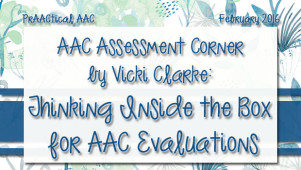
AAC assessment is a challenge in almost every service delivery setting, and many of you have reached out to us to ask for advice on how to strengthen your assessment practices. Luckily, Vicki Clarke, an AAC Chick who has a great deal of experience assessing learners in clinical and educational settings, has tips and resources to share. In this continuation of the AAC Assessment Corner series, Vicki talks about a key feature in any AAC system: vocabulary organization. ::::::::::::::::::::::::::::::::::::::::::::::::::::::::::::::::::::::::::::::::::::::::::::: Thinking Inside the Box for AAC Evaluations: What Type of Vocabulary Organization is Right For Your AAC User? Professionals often spend a great deal of time concerning themselves with which box they should get their AAC user. Should I pick a Prentke Romich or a Tobii Dynavox? But what about the iPad? And what about the money? Should I pick a CheapTalk or a GoTalk instead? Here’s the good news: The box is not the... [Read More...]
January 11, 2016
by Carole Zangari -
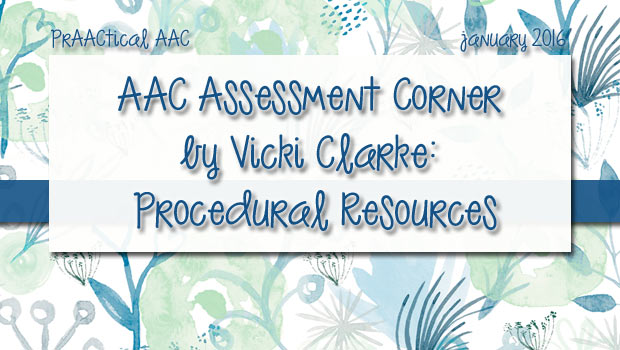
The new year is bringing some changes to PrAACtical AAC, and one that I am most excited about is a regular monthly article by SLP Vicki Clarke. Vicki is a phenomenal clinician with a private practice in Georgia who has been specializing in AAC since 1991. Her practice, Dynamic Therapy Associates, averages around 50 AAC evaluations a year, so she was the perfect choice to write about AAC assessment practices. Vicki’s assessments are for both for individuals and school districts, and include clients of all ages (peds through adults) who have a variety of challenges and etiologies (e.g., motor disorders, memory, attention and learning difficulties, sensory impairment, neurological differences, syndromes and seizure disorders, congenital and acquired difficulties). Click on these links to learn more about Vicki’s life as an AAC therapist and the kinds of supports provided at Dynamic Therapy Associates. I know you will appreciate the resources, ideas, and tips that Vicki... [Read More...]









